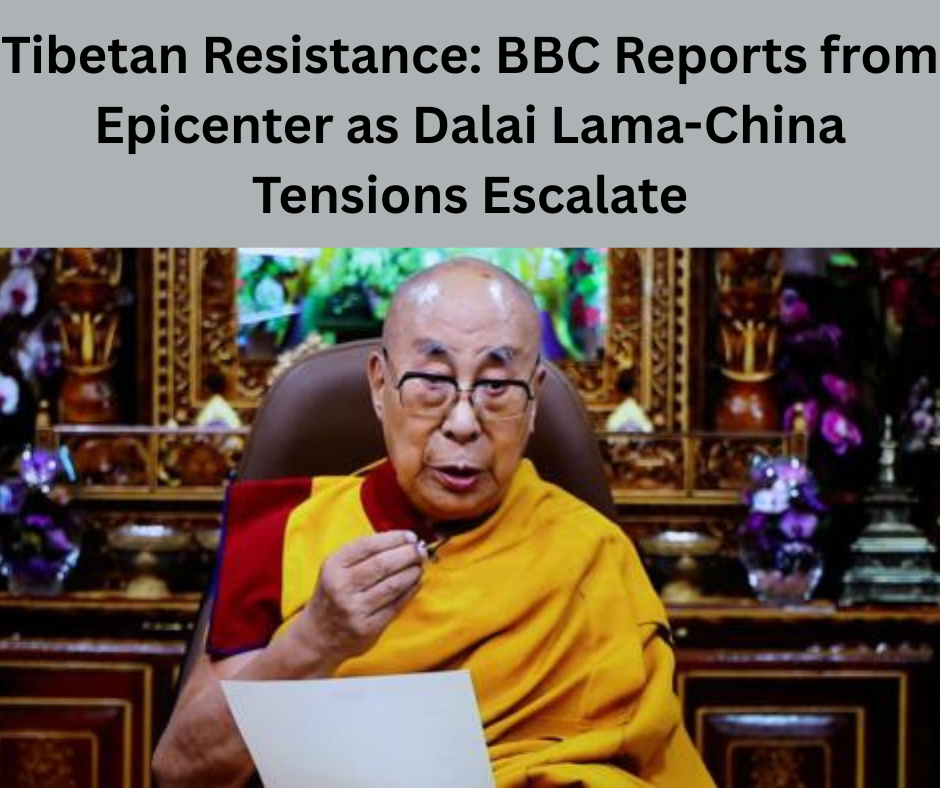Tibetan Resistance:
Tibetan Resistance: BBC Enters the Heart of Dissent in Sichuan
Tibetan Resistance in Kirti Monastery: Quiet Courage in Sitka of Surveillance
Shrouded in crimson robes and gripping prayer beads, a monk at Kirti Monastery in Sichuan’s Aba (Ngaba) district spoke softly to BBC reporters about the ongoing Tibetan Resistance. With eight unidentified men trailing us, even a brief statement placed him at risk. “Things here are not good for us,” he murmured before slipping away.
Tibetan Resistance Under Watch: High Security Surrounds Sacred Spaces
Once a symbol of Buddhist devotion and peaceful defiance, Kirti Monastery now stands heavily fortified. A police station sits at its entrance, surrounded by surveillance cameras on steel poles scanning every move. Inside, the quiet squeak of prayer wheels echoes beneath the heavy eyes of state scrutiny. This palpable tension marks a key site of Tibetan Resistance, stretching back decades.
Tibetan Resistance and the State: Economic Development, Cultural Control
The Chinese state has poured infrastructure investment into Tibetan regions—roads, railways, hotels—to blend them into the national fabric. Yet these developments also support tighter control. In Aba, a stronghold of Tibetan Resistance, locals report increased troops, injections of Mandarin-only education, and gated restrictions on religious practice.
Tibetan Resistance Rooted in Devotion: A History of Protest and Self-Immolation
Aba’s reputation as a cradle of Tibetan Resistance dates back to the 2008 uprisings following a monk’s act of defiance. Clashes ensued, leaving dozens dead, and the protests devolved into violent confrontations between paramilitary forces and mourners. Around 150 self-immolations have occurred in the region over recent years—the harshest demonstrations of resistance in the face of repression.
Tibetan Resistance in Daily Life: Hidden Voices at Dawn Prayers
One pre-dawn morning, BBC journalists slipped past minders to attend morning prayers. Monks in yellow Gelug hats chanted, drifting misty smudge smoke marking spiritual continuity. “The Chinese government has poisoned the air in Tibet,” one monk quietly told them. “We Tibetans are denied basic human rights.” Their words, threatening in this environment, echo centuries of suppressed faith—and undying Tibetan Resistance.
Tibetan Resistance and the Dalai Lama Succession: A Looming Test
As the Dalai Lama turns 90, attention shifts to his succession—becoming a central axis in the struggle of Tibetan. Abroad in Dharamsala, the spiritual leader reaffirmed that his successor must follow traditional reincarnation practices. But in Chinese-controlled Tibet, even whispering his name is forbidden. Beijing asserts that any successor must be sanctioned and elected under Communist Party oversight.
Tibetan Resistance and Identity: Threatened by Mandarin Mandates
New education policies enforce Mandarin as the sole language in Tibetan schools, eliminating scripture lessons until age 18. Some monasteries have already been demolished—another blow to Tibetan rooted in cultural and religious identity. Tibetan scholars warn that this educational shift could erode noble Buddhist traditions.
Tibetan Resistance and Infrastructure: Roads, Rails, and Cultural Dilution
The road to Aba spans 500 km of mountainous terrain, traversing snowy plateaus and yak pastures. But the new high-speed rail and highways have also served surveillance and development goals. Boutique hotels and souvenir shops now operate alongside prayer halls—signifying another front where Tibetan is being challenged by tourism and sinicization.
Tibetan Resistance in the Streets: Smiles Amid Surveillance
Facial-recognition cameras at hotel lobbies and petrol stations remind each Tibetan that identity, culture, and autonomy are under constant state scrutiny. Yet even here, villagers spin prayer wheels, hum hymns, and smile, asserting quiet forms of Tibetan in everyday life.
Tibetan Resistance and the Future: Reincarnation as Battleground
While the Dalai Lama plans for a successor chosen freely, Beijing is preparing to assert its own version of legitimacy. The 1995 Panchen Lama episode raised alarms when Beijing abducted the Dalai Lama’s chosen successor, replacing him with a more compliant one. Analysts caution that control over the next Dalai Lama will define the battlefield for Tibetan after this generation.
Tibetan and Global Attention: The Role of Exile Voices
Much of what emerges about the plight of Tibetan people comes from those in exile or foreign journalists like the BBC. In Tibet itself, information is carefully filtered. This disconnect is part of China’s broader strategy to isolate Tibetans and suppress Tibetan both physically and virtually.
Tibetan: A Test of Way Forward
At dawn prayers, the monk’s quiet echoes—combined with whispered hopes for a successor untainted by state control—sum up the enduring spirit of Tibetan Resistance. The challenge ahead is monumental: to preserve cultural identity and self-rule under the unblinking eye of surveillance and political assimilation.
Read more: July 4 Closures 2025

[…] Read more: Tibetan Resistance […]